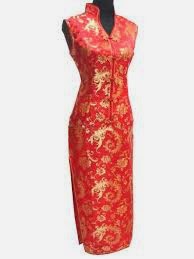CHEONGSAM
When the Manchus ruled China during the Qing Dynasty, certain social strata emerged. Among them were the Banners, mostly Manchus, who as a group were called Banner People. Cheongsam was derived from the garment of banner people and it was the basal garment for the Manchus in Northeast China.
Cheongsam is a tight-fitting one-piece Chinese dress for women. It is known in Mandarin Chinese as the qípáo 旗袍 and is also known in English as a Mandarin gown.
The original qípáo was wide and loose covering most of the woman's body, revealing only the head, hands, and the tips of the toes. The baggy nature of the clothing conceals the figure of the wearer of any age.
The modernised qípáo was created in the 1920s in Shanghai and made fashionable by socialites and upper class women as it accentuates the figures of women. As Western fashions changed, the basic qípáo design changed too, introducing high-necked sleeveless dresses, bell-like sleeves, floral painting dress, art painting dress and mini qípáo dress.
The original qípáo was wide and loose covering most of the woman's body, revealing only the head, hands, and the tips of the toes. The baggy nature of the clothing conceals the figure of the wearer of any age.
The modernised qípáo was created in the 1920s in Shanghai and made fashionable by socialites and upper class women as it accentuates the figures of women. As Western fashions changed, the basic qípáo design changed too, introducing high-necked sleeveless dresses, bell-like sleeves, floral painting dress, art painting dress and mini qípáo dress.
Qípáo features strong national flavour and embodies the beauty of Chinese traditional costume. It has also become a symbol of the oriental traditional costume.
Changshan, a traditional Chinese dress, is the male equivalent of the women's cheongsam and are traditionally worn in pictures, weddings, and other more formal historically Chinese events. It is a loose fitting long shirt or gown that buttons across the chest and down the side with traditional Chinese frog buttons. Changshan features a Mandarin Collar with an inner detachable collar. There are side slits on either side. Changshan may be worn full length, calf length or knee length.
Changshan are not often worn today except during traditional Chinese celebrations. A black Changshan, along with a round black hat, was, and sometimes still is, the burial attire for Chinese men.
Changshan are not often worn today except during traditional Chinese celebrations. A black Changshan, along with a round black hat, was, and sometimes still is, the burial attire for Chinese men.








No comments:
Post a Comment